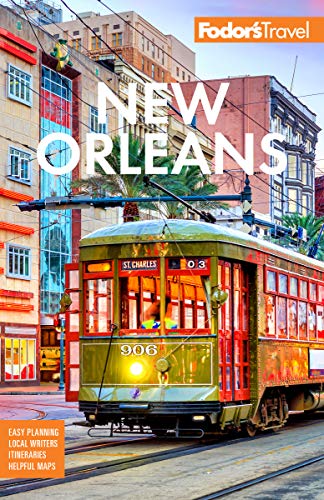Riding the Streetcar in New Orleans
View the beautiful mansions and experience the fun local vibe of Uptown via the St. Charles Avenue streetcar, which runs the length of the avenue, from Canal Street right outside of the French Quarter to Carrollton-Riverbend. The relaxing ride takes about an hour and costs $1.25 one-way.
If you're coming from the French Quarter, board at Canal and Carondelet. Jump off at Jackson Avenue (a 20-minute ride) and follow our Garden District Walking Tour . Reboard at Louisiana Avenue, which forms the boundary between the Garden District and Uptown. As you approach Louisiana Avenue, the huge white mansion on your left at the intersection was formerly the Bultman Funeral Home,whose interiors inspired Tennessee Williams when he was writing his play Suddenly Last Summer. It’s now a Fresh Market grocery store. Note that unless you have an unlimited day pass ($3) for the streetcar, you'll need to ask for a 25¢ transfer when you pay—otherwise you'll have to pay the full $1.25 (exact change) each time you board.
Streetcar History
In the 1900s, streetcars were the most prominent mode of public transit in New Orleans, and by the early 20th century, the city had almost 200 miles of streetcar lines; a ride cost just 5¢. In the 1920s, buses started to overtake the old-fashioned system. Four lines operate today, with plans for expansion under way.
The Columns Hotel, built in 1883 as a private home, is on the right after Peniston Street. It's a great place for a cocktail on the grand veranda or for a casual brunch on Sunday. Next, you'll pass the Gothic-style Rayne Memorial Methodist Church, built in 1875, one block past the hotel on the left. The 1887 Queen Anne–style Grant House up the block was designed by local architect Thomas Sully, with a decorative porch and balcony balustrades.
As you continue, the large avenue at the next stop is Napoleon. The spectacular Academy of the Sacred Heart, a private girls' school, is on the right in the next block, past Jena Street. Across the street, the Mediterranean Smith House claims one of the most picturesque settings on the avenue. It was built in 1906 for William Smith, president of the New Orleans Cotton Exchange. The Anthemion, at 4631 St. Charles Avenue, designed by architect Frank P. Gravely, is an early example of Colonial Revival architecture. The Brown House, on the right before Bordeaux Street, is one of the largest mansions on St. Charles Avenue.
Several houses in the next block are turn-of-the-20th-century buildings that emulate an antebellum style. On the left, at No. 4920, is the Colonial Revival Rosenberg House, built in 1911. At No. 5120 is the Milton H. Latter Memorial Library,inside a beaux-arts mansion. It's one of the few mansions along St. Charles open to the public.
Several blocks ahead, the Benjamin House, between Octavia and Joseph streets, is a stunning mansion (circa 1916) with a stone facade designed by the architect Emile Weil. On the next block, past Joseph Street on the right, is the McCarthy House, a 1903 Colonial Revival home with ornate columns and flattop doors and windows. The plantation home used in the film Gone With the Wind was a set, but it served as inspiration for the columned New Orleans Tara, built in 1941, at the corner of Arabella.
As you cross Nashville Avenue, the Wedding Cake House, an elaborate Victorian mansion built circa 1896, is on the right. Its most notable feature is the beveled leaded glass in its front door, one of the most beautiful entryways in the city. As you enter the university district, dominating the next block on the left is the neo-Gothic St. Charles Avenue Presbyterian Church.
Castles House, on the left after State Street, is in the Colonial Revival style, as is the St. Charles Avenue Christian Church, two blocks up on the left. On the right, across from the church, is Temple Sinai, the first Reform Jewish congregation in New Orleans. This building dates from 1928; the annex on the corner was built in 1970.
Just beyond Calhoun Street, Loyola University, on the right, takes up the block after Temple Sinai. Tulane University, founded in 1834, is directly beside Loyola. Campuses for both universities extend several blocks off the avenue. On the left, across the avenue from the two universities, is Audubon Park.
Back on the streetcar, the heavy stone archway on the right just after Tulane University is the guarded entrance to Audubon Place. The private drive has some of the most elegant mansions in the city. Zemurray House, the columned white home facing the archway, was built in 1908 by the cotton broker William T. Jay, who sold it to Samuel Zemurray, head of the United Fruit Company. It is now the official residence of Tulane's president. The Doll House, a miniature house in the corner yard on the right at Broadway, is said to be the smallest house in New Orleans with its own postal address.
At Broadway, to the left, is the Loyola University School of Law, an Italianate building that housed the Dominican Sisters and the college they operated until the 1980s. The street continues several more stops past Broadway along St. Charles until it turns at the Riverbend onto Carrollton Avenue, once the entrance to a former resort town.
You'll travel through the Carrollton-Riverbend neighborhood before reaching the end of the line at Palmer Park, where an arts market is held the last Saturday of every month. Reboard the streetcar headed downtown at South Carrolton Avenue and Claiborne Avenue, where the St. Charles Avenue line both begins and ends.




